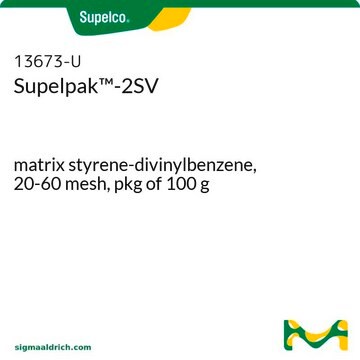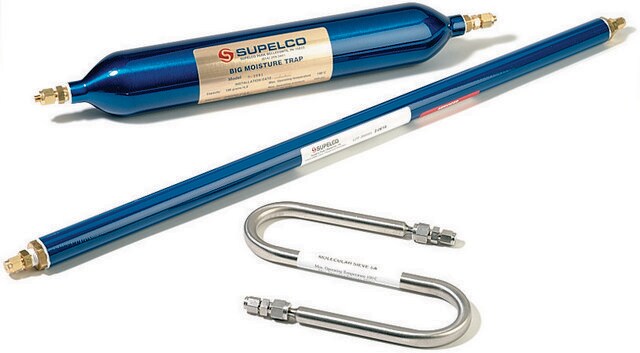10199
Carbosieve Carbon Adsorbent
matrix Carbosieve G, 80-100 mesh, bottle of 5 g
About This Item
Produits recommandés
product name
Carbosieve Adsorbent, matrix Carbosieve G, 80-100 mesh, bottle of 5 g
Gamme de produits
Carbosieve
Niveau de qualité
Forme
powder or granules
Conditionnement
bottle of 5 g
Technique(s)
LPLC: suitable
gas chromatography (GC): suitable
solid phase extraction (SPE): suitable
Superficie
~1160 m2/g
Matrice
Carbosieve G
Groupe de la matrice active
carbon
Taille des particules
80-100 mesh
Dimension de pores
~0.02 cm3/g mesoporosity
~0.49 cm3/g microporosity
~0 cm3/g macroporosity
~6-15 Å pore diameter
Densité
~0.27 g/mL (free fall density)
Technique de séparation
reversed phase
Vous recherchez des produits similaires ? Visite Guide de comparaison des produits
Description générale
- Spherical (better packed bed performance than granular particles)
- Hard and non-friable (pack well, will not break)
- Highly porous (high surface areas)
- Used for molecules with an analyte size relative to C2-C5 n-alkanes
- Hydrophobic (can be used in high humidity environments)
Generally, CMS adsorbents offer greater relative adsorptive strength compared to spherical graphitized polymer carbon (SGPC) and graphitized carbon black (GCB) adsorbents. Our Carbosieve products are a type of CMS adsorbent.
- Have non-tapered pores
- Very strong adsorptive strength due to only containing micropores
- Provide great performance for many small, volatile analytes that most adsorbents have trouble retaining
For more information about any of our specialty carbon adsorbents, please visit sigma-aldrich.com/carbon
Informations légales
Code de la classe de stockage
11 - Combustible Solids
Classe de danger pour l'eau (WGK)
nwg
Point d'éclair (°F)
Not applicable
Point d'éclair (°C)
Not applicable
Équipement de protection individuelle
Eyeshields, Gloves, type P3 (EN 143) respirator cartridges
Faites votre choix parmi les versions les plus récentes :
Certificats d'analyse (COA)
Désolés, nous n'avons pas de COA pour ce produit disponible en ligne pour le moment.
Si vous avez besoin d'assistance, veuillez contacter Service Clients
Déjà en possession de ce produit ?
Retrouvez la documentation relative aux produits que vous avez récemment achetés dans la Bibliothèque de documents.
Notre équipe de scientifiques dispose d'une expérience dans tous les secteurs de la recherche, notamment en sciences de la vie, science des matériaux, synthèse chimique, chromatographie, analyse et dans de nombreux autres domaines..
Contacter notre Service technique








